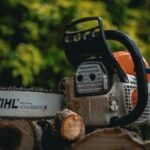As an Amazon Associate, this site earns commissions from qualifying purchases. For more information click here.
The chainsaw, a versatile tool for various cutting tasks, demands regular maintenance to uphold its efficiency and durability. Among the array of upkeep procedures, cleaning the air filter holds paramount importance. A pristine air filter ensures unimpeded airflow to the engine, safeguarding it against dust and debris infiltration.
Key Takeaways:
- Regularly cleaning the chainsaw air filter is vital for maintaining optimal engine performance and prolonging the tool’s lifespan.
- Ensure thorough inspection and gentle cleaning of the air filter to remove dirt and debris, preventing clogs and airflow restrictions.
- Prioritize safety by powering off the chainsaw, wearing protective gloves, and following step-by-step procedures for effective maintenance.
What is an Air Filter For?
The air filter in a chainsaw acts as a gatekeeper, preventing harmful particles like dirt, dust, and debris from entering the engine’s combustion chamber. Over time, these contaminants accumulate on the filter, obstructing the airflow and potentially compromising the engine’s performance. Regular cleaning of the air filter is indispensable to maintain peak engine function and avert costly repairs down the line.
Tools and Materials Needed
Before embarking on the cleaning endeavor, gather the following tools and materials:
- Screwdriver or wrench (depending on your chainsaw model) for accessing the air filter cover.
- Cleaning brush or compressed air for removing debris from the filter.
- Warm, soapy water for deep cleaning.
- Clean cloth or paper towels for drying.
- Protective gloves to shield your hands during the process.
Step-by-Step Guide to Cleaning the Air Filter:
Safety Precautions: Always prioritize safety by ensuring the chainsaw is powered off, and the engine has cooled down before commencing any maintenance tasks. Wear protective gloves to shield your hands from dirt and debris.

Step 1: Access the Filter
Locate the air filter cover, typically positioned near the engine, and secured with screws or clips. Utilize a screwdriver or wrench to loosen the screws or release the clips, granting access to the air filter.
Step 2: Removing the Air Filter
Gently detach the air filter from its housing, taking care not to damage the filter or surrounding components. Inspect the filter for visible signs of damage or excessive dirt buildup. If the filter appears severely clogged or damaged, consider replacing it rather than cleaning.
Step 3: Cleaning
For lightly soiled filters, employ a soft brush or compressed air to delicately remove dirt and debris from the filter’s surface. In cases of stubborn dirt and grease, immerse the air filter in warm, soapy water. Allow it to soak for several minutes to loosen the grime.
After soaking, softly scrub the filter with a brush to dislodge remaining dirt and debris. Rinse the filter thoroughly with clean water and ensure it dries completely before reinstallation.
Step 4: Inspecting and Reinstalling
Prior to reinstalling the air filter, scrutinize the housing for any traces of dirt or debris. Clean the housing meticulously to guarantee proper airflow.
Carefully place the clean and dry air filter back into the housing, ensuring it is seated correctly and securely.
Secure the air filter cover using the screws or clips, tightening them adequately to prevent air leaks.
After cleaning and reinstalling the air filter, start the chainsaw and let it run for a few minutes to ensure all components are functioning optimally.
Monitor the engine for any irregular sounds or performance issues that may signal a problem with the air filter or other constituents. For more info here is a chainsaw engine repair guide.
How to Care for Chainsaw Air Filters
The air filter in a chainsaw plays a crucial role in protecting the engine from harmful debris and ensuring optimal performance. Regular maintenance and occasional replacement of the air filter are essential to keep the chainsaw running smoothly and efficiently.
Maintaining Chainsaw Air Filters
- Schedule regular air filter inspections and cleanings to prevent dirt and debris buildup.
- Use a soft brush or compressed air to remove surface debris.
- For more stubborn dirt, soak the filter in warm, soapy water, scrub gently, and rinse thoroughly before drying.
Store the chainsaw in a clean, dry area to prevent dust and debris from contaminating the air filter. Consider using a protective cover or case to shield the chainsaw when not in use.:
Before each use, inspect the air filter for signs of damage or excessive dirt buildup. Look for tears, holes, or deterioration that may compromise the filter’s effectiveness.
When to Replace Chainsaw Air Filters
Reduced Performance: If you notice a decrease in engine power or efficiency, the air filter may be clogged or worn out. Replace the air filter if cleaning does not restore proper airflow and performance.
Visible Damage: Inspect the air filter regularly for tears, holes, or signs of deterioration. Replace the filter if it appears damaged or worn, as compromised integrity can allow contaminants to enter the engine.
Maintenance Schedule
Follow the manufacturer’s recommendations for air filter maintenance and replacement intervals.
In high-dust or heavy-usage environments, consider more frequent inspections and replacements to ensure optimal performance.
Maintaining chainsaw air filters is essential for preserving engine performance and prolonging the tool’s lifespan. By regularly cleaning and inspecting the air filter, you can prevent debris buildup and ensure efficient operation. Additionally, knowing when to replace the air filter based on performance, visible damage, and maintenance schedules is crucial for maintaining peak performance and avoiding costly repairs.
Can a Chainsaw Run without an Air Filter?
Chainsaws technically can run without an air filter, but it’s highly discouraged and can lead to severe damage to the engine. Here’s why:
Engine Protection. The air filter acts as a barrier, preventing dust, debris, and other particles from entering the engine. Without a filter, these contaminants can infiltrate the engine, causing abrasion, wear, and potential damage to vital components.
Engine Performance. Running a chainsaw without an air filter can lead to a disruption in the air-to-fuel ratio, resulting in inefficient combustion. This inefficiency can lead to decreased engine performance, reduced power output, and potentially overheating.
Increased Wear and Tear. Dust and debris entering the engine can cause premature wear and tear on components such as the piston, cylinder walls, and piston rings. Over time, this can lead to decreased engine lifespan and costly repairs.
Risk of Engine Failure. Operating a chainsaw without an air filter significantly increases the risk of engine failure. Fine particles can infiltrate sensitive engine parts, causing damage that may render the chainsaw inoperable and require extensive repairs or even replacement.
While a chainsaw may technically run without an air filter, it’s not advisable due to the risks associated with engine damage, decreased performance, and potential failure. Proper maintenance, including regular cleaning and replacement of the air filter, is essential for ensuring the longevity and efficient operation of your chainsaw.
What Type of Air Filters Do Chainsaws Use?
Chainsaws typically use two main types of air filters:
Foam Air Filters
Foam air filters are commonly found in chainsaws and other small engines. These filters are made of porous foam material that traps dirt and debris while allowing air to pass through.
Foam filters are relatively inexpensive and can be cleaned and reused multiple times with proper maintenance. They are effective at filtering out larger particles but may require more frequent cleaning compared to other filter types.
Paper Air Filters
Some higher-end or professional-grade chainsaws may use paper air filters. Paper filters are constructed of pleated paper material designed to capture fine dust and debris particles.
Paper filters typically provide better filtration efficiency than foam filters but may need to be replaced more often. They are often considered more convenient since they can be replaced rather than cleaned, but they may be more costly in the long run.
Both foam and paper air filters are effective at protecting the chainsaw’s engine from contaminants, but the choice between them often depends on factors such as the chainsaw model, usage frequency, and personal preference. It’s essential to follow the manufacturer’s recommendations regarding air filter type, maintenance, and replacement intervals to ensure optimal performance and longevity of your chainsaw.
Conclusion
Regularly cleaning the air filter is imperative for preserving the performance and lifespan of your chainsaw. By adhering to the detailed steps outlined above, you can ensure that your chainsaw’s air filter remains free from debris, facilitating optimal engine performance and extending the tool’s longevity.
Remember to conduct this maintenance task at regular intervals, particularly after heavy usage or in dusty environments, to uphold your chainsaw’s efficiency for years to come.

I love the outdoors and all the tools for maintaining gardens, yards and lawns. The only thing I am more passionate about is sharing what I know about garden and outdoor equipment.


